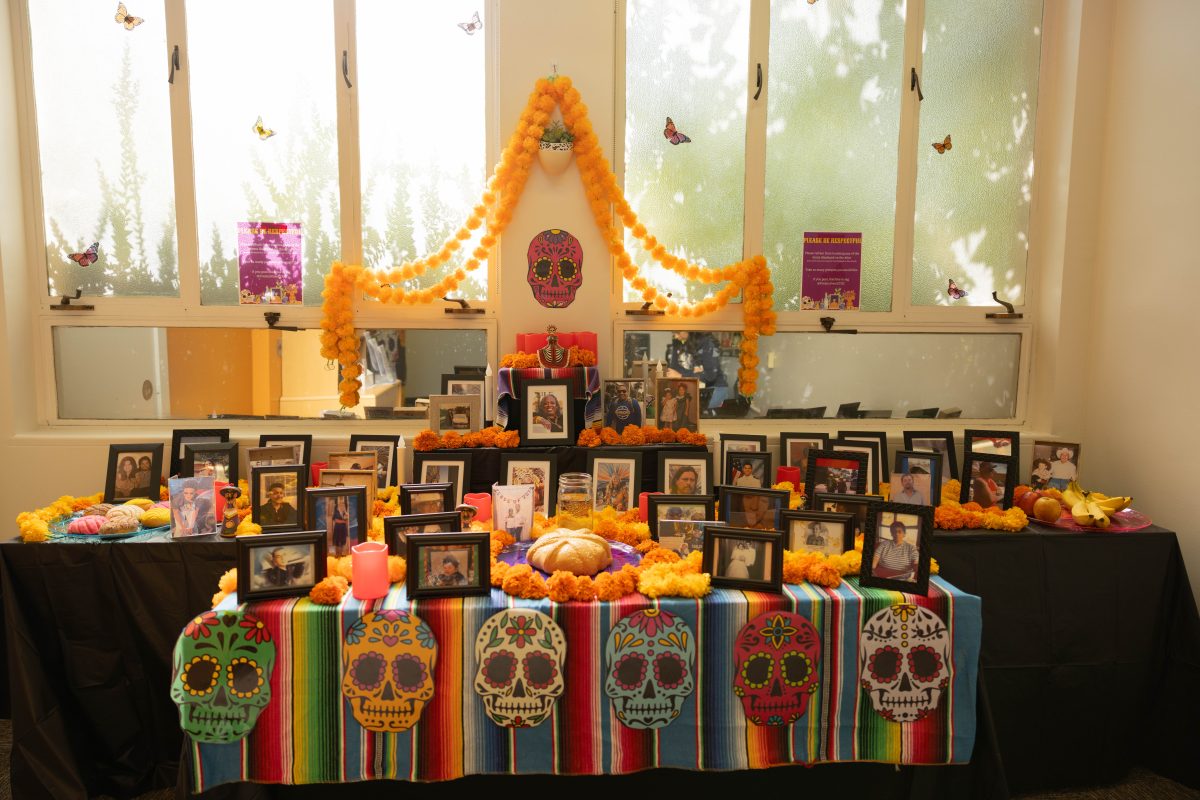In La Casita de Helena Ramirez in the Thomas Building, large tables draped with sarape blankets are decorated with dozens of framed pictures of family members from all backgrounds and age ranges. Candles line the table and fill all the empty spaces from between the photos. Bright orange marigolds sit in front of each picture, with plates of “pan de muerto” and a big glass of water displayed in the center of the altar as offerings for the deceased.
Cross Cultural and Gender Center, with help from the Latino/a Program, displayed a Día de los Muertos ofrenda, an altar with photos provided by students honoring their loved ones that have passed away. The altar was displayed on Nov. 1 and 2.
“It didn’t matter who sent in photos, we wanted to ensure that anyone who wanted to honor their loved ones had the opportunity to join us in celebrating the holiday,” said Cynthia Villalobos, assistant coordinator of the CCGC.
Día de los Muertos, or Day of the Dead, is an annual Mexican holiday honoring loved ones who passed away. It is often celebrated in every Hispanic community.
On the first two days of November each year, people come together to welcome the souls of their deceased loved ones. Día de los Muertos consists of rituals, altar making, food, music, dancing and the reunion of generations.
Altars are built with the intention of remembering the deceased and decorated with photographs and candles. Every altar includes one of each of the four elements: water, earth, wind, and fire.
Ofrendas, or offerings, are the things that are placed on the altar for the spirits. Water is left in a cup so spirits can quench their thirst. Papel picado represents the wind, earth is represented by food, especially bread, and candles represent the cardinal directions, so the spirits can find their way.

Marigolds are the chosen flower for Día de los Muertos and are considered to attract souls and guide deceased family members back to the living world.
When visiting the altar in the Thomas Building, viewers are met with every color imaginable. The room was quiet, allowing a safe space for grief and remembrance. Each portrait also has an offering of pan dulce on platters.
The CCGC allowed students to submit photos of their loved ones via email to be displayed on an altar in remembrance and to honor their memories.
“The ofrenda contributes to our campus community by allowing our campus to celebrate what they celebrate,” Villalobos said. “It’s a great opportunity for those who may not have the space to create an ofrenda in their living areas but still want to celebrate the holiday with their community here at Fresno State.”
Juana Gonzalez, a full-time staff member and student, submitted pictures of both sets of her grandparents to be featured on the altar.
“I have fond memories of both sets of my abuelitos,” Gonzalez said. “They were both very loving towards their grandchildren. As a child, I would go every December to visit my paternal grandparents in Mexico City for about a week and a half. I loved going to Mexico. They alway welcomed me with open arms. A special memory I have with my paternal grandfather is that he would take me for cart rides in a couple streets in Mexico City.”
Gonzalez also stressed the importance of having interactive celebrations like CCGC’s ofrenda to allow students to participate and celebrate the culture and their loved ones.
“It was important and I’m grateful to CCGC for giving students and staff opportunities to honor our loved ones by creating an ofrenda for Día de los Muertos,” Gonzalez said.




